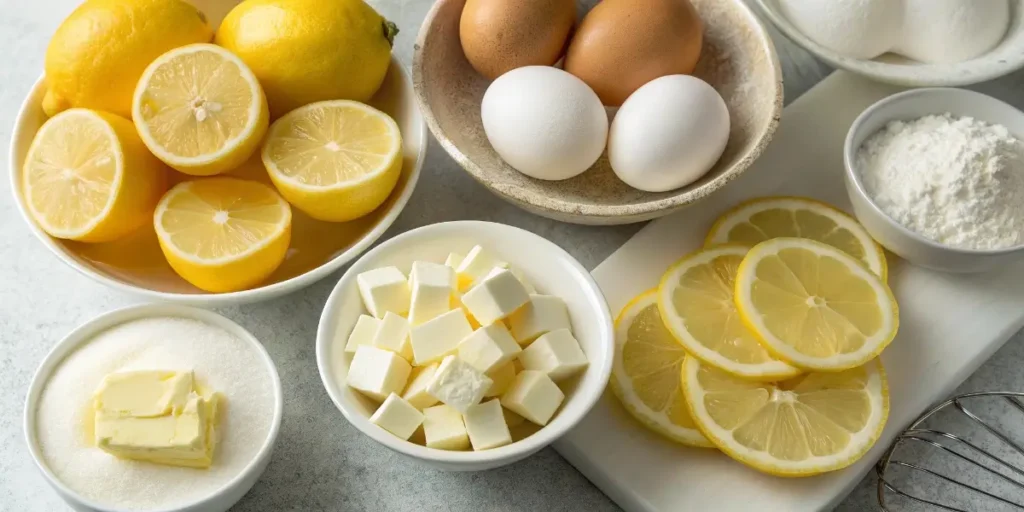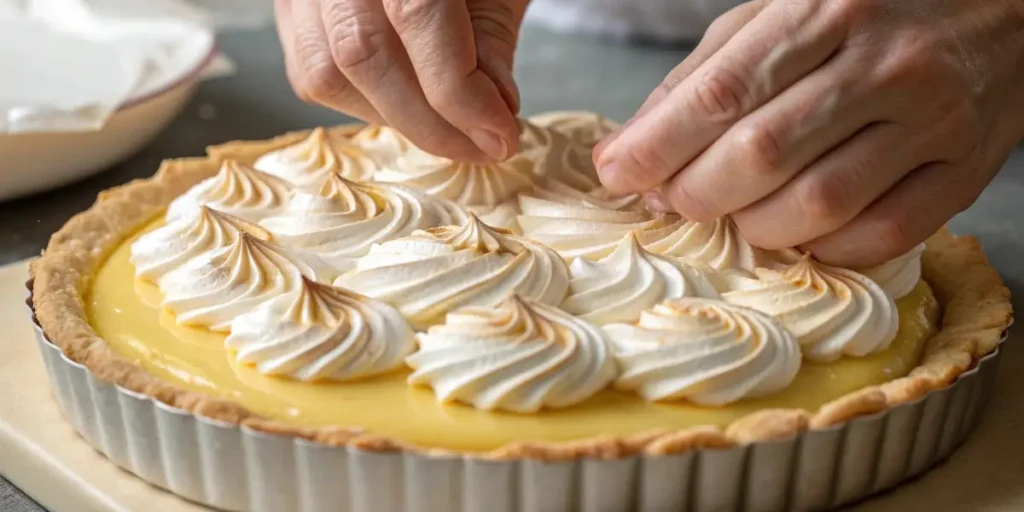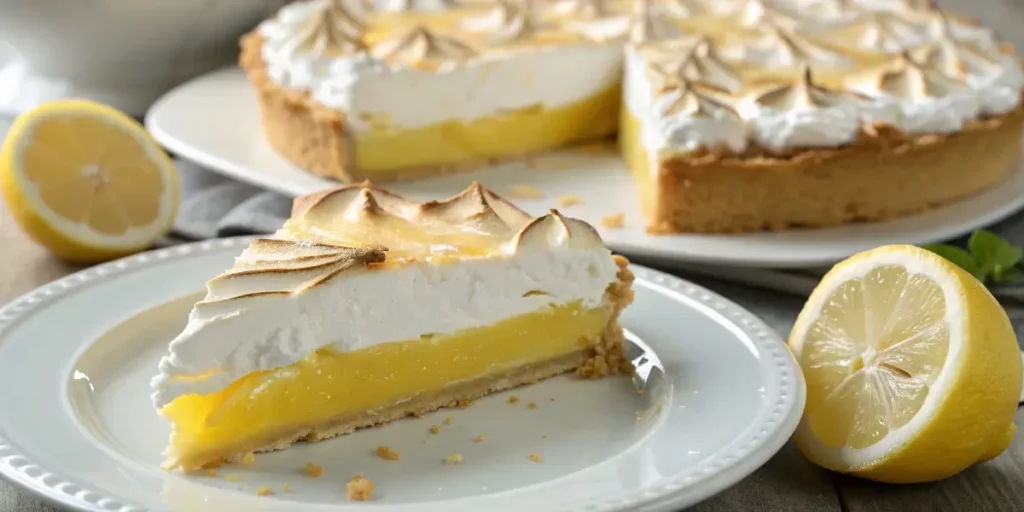Lemon and Meringue Pie Recipe – The Ultimate Homemade Dessert Guide
Lemon and meringue pie is a dessert that captures pure comfort and nostalgia in one bite. The tang of the lemon filling balanced with the sweetness of the meringue creates a flavor that’s both refreshing and indulgent. Whether it’s for a family dinner, a holiday gathering, or a weekend treat, mastering the perfect lemon and meringue pie recipe is an experience every home baker should have.
In this guide, we’ll uncover every detail—from understanding what makes lemon and meringue pie unique to the science behind its silky texture and cloud-like topping. We’ll also walk through step-by-step techniques for creating the perfect meringue, tips to prevent sogginess, and expert tricks to achieve that golden-brown finish.
Looking for inspiration? Try Easy Recipe for Heart-Shaped Cakes or Lemon Oatmeal No-Bake Cookies for more delightful desserts.
Table of Contents
Understanding Lemon and Meringue Pie
What Is Lemon and Meringue Pie?
Lemon and meringue pie is built on three layers that together create a dessert masterpiece. The base is a buttery, flaky crust—either homemade or store-bought—that provides structure and a subtle crunch. Next comes the vibrant lemon filling, usually made from egg yolks, sugar, lemon juice, and zest, cooked until thick and smooth. Finally, the pie is topped with a soft meringue made from whipped egg whites and sugar, baked until slightly toasted and golden on top.
The beauty of this dessert lies in its balance: the sweetness of the meringue offsets the sharpness of the lemon, while the crust adds a satisfying contrast in texture. It’s elegant, versatile, and truly timeless.
The History Behind Lemon Meringue Pie
The roots of lemon meringue pie stretch back to the 18th century, when European bakers began combining citrus curds with sweet pastry bases. The meringue topping—believed to have originated in Switzerland—was later added to elevate both the flavor and presentation. By the 19th century, lemon meringue pie had become a symbol of refined home baking, appearing in American cookbooks as a dessert worthy of celebrations.
Over time, it evolved from a high-end delicacy to a comforting household favorite. Today, it remains a cornerstone of classic dessert menus, admired for its simplicity and balance of flavors.
Difference Between Lemon Pie and Lemon Meringue Pie
What Makes Lemon Meringue Pie Unique
While both lemon pie and lemon meringue pie share a citrusy heart, the difference lies mainly in their textures and topping. A traditional lemon pie typically has a lemon custard filling baked into a simple pastry crust, sometimes topped with whipped cream or left plain. The lemon and meringue pie recipe, however, adds an airy meringue topping that completely changes its character.
The meringue not only introduces a delicate sweetness that balances the tartness of the lemon filling but also adds a stunning, cloud-like texture that melts in your mouth. This fluffy layer, lightly browned in the oven, creates a visual contrast that turns a humble lemon pie into a showstopper.
The preparation methods also differ. Lemon pies are often baked until the custard sets, while lemon meringue pies involve an extra step: whipping egg whites to stiff peaks and gently toasting them for a glossy, golden finish. This layer of meringue acts like a sweet, protective blanket, sealing the lemon curd and keeping it fresh.
If you enjoy creamy desserts with layered textures, you might also love Pistachio No-Bake Cheesecake or Amish Apple Cake Recipe — both offer that same satisfying balance of sweetness and texture.
Comparing Texture, Taste, and Ingredients
Here’s a quick look at how the two pies differ in key characteristics:
| Feature | Lemon Pie | Lemon Meringue Pie |
|---|---|---|
| Topping | Plain or whipped cream | Whipped meringue, toasted |
| Texture | Smooth and dense | Light, airy, creamy, layered |
| Flavor Balance | Mostly tart | Sweet and tart balance |
| Presentation | Simple | Elegant and glossy top |
When comparing their taste, lemon pie delivers pure citrus sharpness, while lemon meringue pie tempers it with the pillowy sweetness of the meringue. Ingredient-wise, both share lemon juice, sugar, eggs, and butter. However, meringue pies require extra egg whites and sugar to create the topping.
The final distinction is emotional—lemon pie is comforting; lemon meringue pie feels celebratory. It’s the difference between everyday baking and a dessert that turns heads at the table.
Don’t miss our Peach Pie Recipe with Canned Peaches for another timeless fruit-filled treat.
Essential Ingredients for Lemon and Meringue Pie Recipe

Key Ingredients for the Lemon Filling
The soul of a lemon and meringue pie recipe lies in its smooth, tangy filling. This vibrant layer bridges the buttery crust with the sweet, cloudlike meringue topping. To make the perfect lemon filling, you’ll need fresh, high-quality ingredients that deliver both richness and sharp citrus flavor.
Here’s what you’ll need:
| Ingredient | Purpose | Tips |
|---|---|---|
| Egg yolks | Adds thickness and creaminess | Use room temperature yolks for smoother texture |
| Lemon juice | The star flavor; provides tartness | Always use freshly squeezed juice for a bright flavor |
| Lemon zest | Intensifies citrus notes | Grate only the yellow part to avoid bitterness |
| Sugar | Balances acidity | White granulated sugar works best |
| Cornstarch or flour | Thickens the filling | Stir continuously to prevent lumps |
| Butter | Adds silkiness and a glossy finish | Unsalted butter ensures better control of flavor |
The secret to success is patience—cook the mixture over medium heat, stirring constantly, until it thickens to the consistency of a curd. Once done, pour it directly into the warm crust to prevent separation.
If you love lemon-based desserts, you’ll also enjoy Lemon Oatmeal No-Bake Cookies for a quick and easy twist on the same tangy theme.
Meringue Topping Essentials
The crowning glory of the lemon meringue pie is its soft, airy topping. Meringue is made by whipping egg whites with sugar until glossy peaks form, creating a light layer that toasts beautifully in the oven.
You’ll need:
- Egg whites – Fresh eggs at room temperature whip best.
- Granulated sugar – Stabilizes the whites and adds shine.
- Cream of tartar or lemon juice – Helps create stable peaks and prevents collapsing.
- A pinch of salt – Enhances overall flavor.
When spreading meringue over the hot lemon filling, ensure it touches the crust edges to seal in steam. This prevents the topping from shrinking during baking. Bake until golden brown, and you’ll have that picture-perfect pie ready for any celebration.
Check out Perfect Boston Cream Cake for another dessert with that same creamy, layered indulgence.
How to Make Lemon and Meringue Pie Step-by-Step
Preparing the Perfect Lemon Filling
A flawless lemon and meringue pie recipe begins with a smooth, glossy lemon filling. It’s the bright, zesty center that makes every bite unforgettable. Follow these steps for a silky, tart filling that never curdles or becomes grainy.
- Whisk dry ingredients first. In a saucepan, combine sugar, cornstarch, and a pinch of salt. Mixing these before adding liquids prevents lumps from forming later.
- Add wet ingredients slowly. Gradually whisk in water, lemon juice, and zest until the mixture is well-blended and smooth.
- Cook and thicken. Heat over medium, stirring constantly until it starts to bubble and thicken. Don’t rush this step—consistent stirring ensures a smooth texture.
- Temper the egg yolks. In a separate bowl, whisk the yolks. Slowly pour a small amount of hot lemon mixture into them, whisking continuously. Then return it all to the pan and cook for another minute.
- Add butter for richness. Remove from heat and stir in butter until fully melted. The butter gives the filling its glossy finish and luxurious texture.
- Pour into a baked crust. Spread the filling evenly while still hot to prevent separation and air pockets.
Your filling should be vibrant yellow, thick, and glossy—firm enough to slice cleanly once cooled.

If you like creamy desserts, don’t miss Pistachio No-Bake Cheesecake — a no-bake dream that also uses smooth, thick layers for perfect texture.
Assembling and Baking the Pie
The final stage is where everything comes together beautifully. You’ve made your crust, your lemon filling is rich and fragrant, and now it’s time to add the fluffy meringue topping.
- Prepare the meringue while the filling is hot. The warm filling helps cook the underside of the meringue, sealing it to prevent weeping.
- Spread meringue to the edges. Use a spatula to ensure the meringue touches the crust. This step is crucial—it locks in moisture and keeps the topping from shrinking.
- Create peaks. Swirl and lift your spatula to create small peaks. These will brown beautifully in the oven.
- Bake until golden. Place the pie in a preheated oven at 350°F (175°C) for about 10–15 minutes, or until the meringue turns a warm golden color.
- Cool gradually. Let the pie cool at room temperature before refrigerating. This step helps the filling set while keeping the meringue soft and fluffy.
When sliced, your pie should show three distinct layers—crisp crust, tangy lemon filling, and perfectly toasted meringue.
Looking for more baking inspiration? Check out Delicious Toll House Cookies for another timeless classic that pairs beautifully with coffee or tea.
How to Make Meringue for Lemon Tart
Step-by-Step Guide to Fluffy Meringue
Making perfect meringue for your lemon and meringue pie recipe is all about precision and patience. The right texture should be light, glossy, and stable enough to hold its peaks. Follow this step-by-step process to achieve meringue perfection:
- Use room temperature egg whites. Cold whites don’t whip as easily. Leave your eggs out for at least 30 minutes before separating them.
- Avoid any yolk contamination. Even a drop of yolk can ruin the meringue’s ability to whip up properly. Use a clean, dry bowl and utensils.
- Add an acid stabilizer. Whisk in 1/4 teaspoon of lemon juice or cream of tartar per 4 egg whites. This helps strengthen the protein bonds, giving your meringue more structure.
- Whip at medium speed first. Beat until the whites become frothy, then gradually increase the speed.
- Add sugar slowly. Pour in sugar one tablespoon at a time, allowing it to dissolve completely before adding more. This ensures a glossy finish and smooth texture.
- Check for stiff peaks. When the meringue holds firm peaks and looks shiny, it’s ready to spread on the pie.
If done correctly, your meringue should look like soft clouds and hold its form even when you lift the whisk. This is your signal to stop beating—overwhipping can lead to dryness and cracking.
For more dessert techniques, discover Perfect Boston Cream Cake for another silky, layered masterpiece.
Common Mistakes to Avoid When Making Meringue
Even experienced bakers can stumble when preparing meringue. Here are the most common pitfalls and how to avoid them:
- Adding sugar too early. Wait until the whites are foamy before introducing sugar, or your mixture might not aerate properly.
- Skipping acid. Without lemon juice or cream of tartar, your meringue can collapse or separate after baking.
- Whipping too long. Overbeating makes meringue grainy and dry. Stop once it reaches stiff, glossy peaks.
- Spreading on cold filling. Always apply meringue to warm lemon filling to prevent weeping and ensure a strong bond.
- Baking too hot. High heat can brown the meringue too quickly, leaving the inside uncooked. Stick to 350°F and monitor closely.
Perfecting your meringue takes practice, but once you get it right, your pie will have that irresistible cloud-like top every time.
Don’t miss our Red Velvet Waffles Recipe for another light and fluffy treat you can whip up easily at home.
Why Lemon Juice Matters in Meringue
The Science Behind Lemon Juice in Meringue
Lemon juice plays a surprisingly vital role in the lemon and meringue pie recipe. A few drops of acid stabilize the egg whites, making them stronger and less likely to collapse. The acid tightens the proteins in the whites as they whip, creating a sturdier foam that holds its glossy shape. Without it, your meringue could weep or deflate quickly after baking.
Adding lemon juice also helps prevent overbeating—a common mistake that causes dryness or graininess. The result is a silky, smooth meringue with soft peaks that toast beautifully.
What Happens If You Skip the Lemon Juice
Leaving out lemon juice won’t ruin your pie, but the meringue won’t be as stable. It might deflate faster or weep moisture over time. If you’re out of lemons, cream of tartar or a few drops of white vinegar can serve as a reliable substitute.
For another tip-packed dessert, check out Amish Apple Cake Recipe — simple, moist, and full of flavor.
Tips for Perfecting Your Lemon Meringue Pie
Preventing a Weepy or Watery Meringue
Weeping meringue is one of the most common frustrations for bakers. The key is temperature control. Always spread meringue over hot lemon filling; this seals the two layers and prevents separation. Avoid overbaking—the moisture inside needs time to set gently.
Getting the Crust Golden and Crisp
For a crisp crust, blind-bake it before adding your filling. Line the crust with parchment, fill it with pie weights or dried beans, and bake at 375°F for 10–12 minutes. This ensures it stays flaky even after baking the entire pie.
Want more baking inspiration? Don’t miss Sourdough Apple Fritter Bread — a deliciously moist loaf packed with apple goodness.

Conclusion and Serving Ideas
Best Ways to Serve Lemon and Meringue Pie
A freshly baked lemon and meringue pie is best enjoyed slightly chilled. Let the pie cool completely at room temperature for about an hour, then refrigerate it for another two before slicing. This helps the lemon filling set while keeping the meringue soft and pillowy.
When serving, use a warm, clean knife for smooth cuts that won’t drag the meringue. Pair your slice with a dollop of whipped cream, a sprinkle of lemon zest, or even fresh berries for a pop of color. This dessert pairs beautifully with tea, coffee, or a light sparkling drink.
If you enjoy creamy and tangy combinations, try Delicious Moroccan Chicken Tagine or Mango Sago Recipe for refreshing meal pairings.
Storage, Freezing, and Reheating Tips
Lemon meringue pie can be stored in the refrigerator for up to three days. Keep it loosely covered with plastic wrap or in a pie container to protect the meringue from moisture. Avoid freezing, as the texture of both the filling and meringue can break down when thawed.
If you must prepare it ahead of time, bake the crust and lemon filling a day early, refrigerate, then make and add the meringue topping just before serving for the freshest taste.
Don’t miss our Delicious Smoked Salmon Brine Recipe for another kitchen classic that focuses on balance and precision—just like this pie.
FAQs
What is the difference between lemon pie and lemon meringue pie?
Lemon pie features a simple lemon custard filling, while lemon and meringue pie includes a fluffy meringue topping that adds sweetness and texture. The meringue layer also protects the filling, keeping it smooth and glossy after baking.
What is the filling in lemon meringue?
The filling is a rich lemon curd made from egg yolks, sugar, butter, and freshly squeezed lemon juice. It’s cooked until thick and creamy, giving that tangy balance against the sweet meringue.
How to make meringue for lemon tart?
Whisk room-temperature egg whites until frothy, then gradually add sugar and a few drops of lemon juice or cream of tartar. Beat until stiff, glossy peaks form—this ensures structure and shine when baked.
Why put lemon juice in meringue?
Lemon juice stabilizes the egg whites, preventing collapse. It strengthens the foam so your meringue stays fluffy even after baking.
What not to mix lemon juice with?
Avoid mixing lemon juice directly with dairy without tempering—it can curdle. Also, never add it early to uncooked meringue before whipping; the acid can delay foam formation.
Can you use lemon juice instead of vinegar in meringue?
Yes, lemon juice works perfectly as an acid substitute for vinegar or cream of tartar. It gives the same stabilizing effect with a pleasant citrus note.

